Daily News
by Gail Helmer
[ Send Us News | Archives ]
EU II Patch Released
Strategy First has released new patches for Europa Universalis II, bringing the historical strategy game by Paradox to version 1.03. You can update from the previous v1.02 or the original game and this release "addresses some stability issues, AI fixes and game play tweaks." Download
Takeda Patch Released
Magitech has issued a new patch for Takeda, and this version 2.0 release adds "numerous new features and improvements" to their war game set in feudal Japan Download
Hidden and Dangerous Deluxe Announced
Lonely Cat Games has announced it is finishing work on Hidden and Dangerous Deluxe. A remake of Talonsoft and Illusion Softwork's 3D tactical shooter, Hidden and Dangerous and its Fight for Freedom expansion, the game is being adapted to run on Windows 2000 and Windows XP using DirectX 8.1. Hidden and Dangerous Deluxe utilizes an improved Insanity3D engine that takes advantage of the hardware vertex processing of modern 3D cards. Lonely Cats hopes to attract players to the game with updated compatibility, bug fixes, and faster game code together with added support for voice chat, GameSpy's matchmaking service, and dynamic shadows.
Military News
All Crewmen Rescued After Helicopter Goes Down in Atlantic
Four crewmembers were rescued after their helicopter went down in the Atlantic Ocean Thursday morning (Feb. 7), approximately 100 miles east of the Virginia Capes. The helicopter, attached to USS Seattle (AOE 3), was conducting a vertical replenishment (VERTREP) with USNS Mount Baker (T-AE 34) when the incident occurred at 10:24 a.m. (EST).
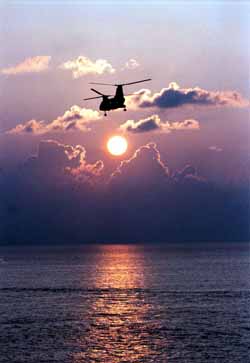
The four crewmembers of the Navy CH-46 "Sea Knight" have been identified as: Lt. Lance Collier, 31; Lt. j.g. Cyndee Brittingham, 28; Aviation Machinist's Mate 2nd Class Kevin Maul, 29; and Aviation Electronics Technician 3rd Class Clifton Lyons, 20. Hometowns were not immediately available.
All four crewmembers were recovered by a second helicopter, also participating in the VERTREP, were returned to USS Seattle. Maul and Lyons were unharmed; the two pilots received minor injuries. Both helicopters belong to Helicopter Combat Support Squadron 6, Detachment 4, embarked aboard Seattle. There was some minor damage done to the flight deck safety nets on Mount Baker. This incident is under investigation. USS Seattle is part of the USS John F. Kennedy (CV 67) Battle Group.
Canada Signs Commitment To JSF Fighter Programme
Canada has become the first country outside the US and UK, to put pen to paper in support of the Joint Strike Fighter (JSF) project, an aircraft that is expected to have a significant impact on the development of aerial warfare over the next thirty years.
US Under Secretary of Defense for Acquisition, Technology, and Logistics Edward C. "Pete" Aldridge, Jr., and his Canadian counterpart Assistant Deputy Minister for Materiel Alan Williams have signed a memorandum of understanding committing Canada to participate in the development and demonstration phase of the programme.
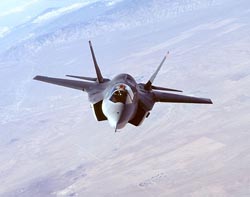
The agreement spans 10 years and will give Canada an advantage over other interested parties when it comes to acquisition of the aircraft. Canadian officials agreed to provide $150 US ($240 Can) million for the development of the prototype aircraft, by comparison the UK is providing $2 billion. "This agreement serves just about every facet of our two countries' national security imperatives," said Aldridge. "Not just in terms of air dominance, but also interoperability, defence transformation, modernisation, cost reduction, acquisition excellence, and the health of our industrial bases."
"This is an important agreement for both the Department of National Defence and Canadian industry," said Williams. "This project will enhance interoperability with US and allied forces, and will provide opportunities for Canadian industry to participate in this cutting-edge aerospace project."
Williams emphasised that the agreement would be of huge worth to Canadian industry: "when we talk in the short and medium term we're certainly talking in this phase, potentially up to 3500 to 5000 jobs we think. As you extrapolate that well into the future, the potential is enormous for maybe 60-plus thousand jobs. That again depends on how successful we are. But we're fairly comfortable that the economic impact in terms of jobs for Canada and Canadians is dramatic."
From the US point of view, the agreement lends credence to claims that the JSF aircraft, nominally the F-35, is generating significant interest from other countries such as the Netherlands, Italy, Denmark, Norway and Turkey. Needless to say prime contractors Lockheed Martin were delighted by the news.
"By joining the Systems Development and Demonstration phase, Canada strengthens the global nature of the programme and further validates the concept of the F-35 as a highly interoperable, common defence asset for multiple allies," said Dain M. Hancock, president of Lockheed Martin Aeronautics Company.
While the Canadian financial input is negligible in a project of this scale, the benefit for Canadian industry both in terms of jobs and experience in being involved in such a high-tech and high profile programme should be pronounced. Equally by attracting support from another western nation the US will be hoping that a bandwagon effect may take hold and that Mr Williams' signature is the first of many.
Lockheed Martin's LOCAAS Successful In Flight Test
Lockheed Martin Missiles and Fire Control's Low Cost Autonomous Attack System (LOCAAS) demonstrated full air vehicle flying qualities and guidance performance in a test this week at Eglin Air Force Base in Florida.
The powered submunition was launched from a test aircraft flying at 200 knots at an altitude of 1,500 feet. After weapon release, the missile flew through a series of pre-determined waypoints, proving its ability to follow a mission-planned course.
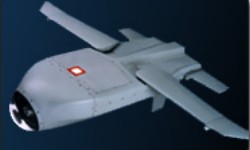
After it passed through the final waypoint, the weapon performed a series of sharp banks, rolls, and turns designed to demonstrate its aerodynamic capabilities.
"LOCAAS provides a unique capability to loiter over the battlefield and take out targets," said Colonel Thomas Masiello, Chief of Air Force Research Labs - Munitions at Eglin Air Force Base. "The warfighter will load in a flight plan and LOCAAS will take out any planned targets that appear in that predetermined area. Monday's test was typical of a mission planned course that LOCAAS might fly in a combat scenario."
LOCAAS uses a Laser Detection and Ranging (LADAR) seeker to determine target aimpoints automatically, using demonstrated Automatic Target Recognition algorithms. It is designed to be compatible with F-16, F-22, Joint Strike Fighter, B-1, and B-2 aircraft. It can also be dispensed from a Multiple Launch Rocket System (MLRS) rocket or an Army Tactical Missile System (ATACMS) missile.
Polish Government Seeks Amendment To Fighter Contract
The Polish Government is to submit proposals to Parliament to amend a $3 billion fighter acquisition programme designed to bring the country's ageing air force up to NATO standards. The original programme requirements were for 44 new aircraft along with 16 second hand aircraft, but the defence ministry has now rethought the proposal raising the number of new aircraft to 48, enough for three squadrons, and scrapping the need for the old aircraft.
Poland, which has been a member of NATO since 1999, currently operates a fleet of sub-standard ex-Soviet fighters and so this project will mark an important stepping stone for Polish defensive capabilities. Pending parliamentary approval, the final decision should be taken in the autumn.
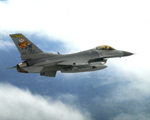
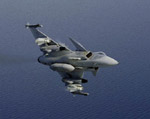
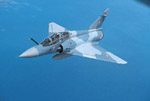
Competing for the tender are Lockheed Martin's F-16, Dassault's Mirage 2000 and the JAS-39 Gripen from a consortium of Saab and BAE SYSTEMS, and the three teams have recently presented their respective offset packages. This aspect of the competition is likely to be crucial as, in similar circumstances, both Hungary and the Czech Republic selected the Gripen due to the generous subcontracting work on offer for the aerospace sectors in those countries.
Raptor Gets Green Light On Refuelling Capability
The F-22 Combined Test Force at Edwards AFB in California has expanded the Raptor's operational capability by certifying the aircraft for "hot-pit" refuelling operations recently. After nearly five months of research, training and demonstrations, certification will allow the F-22 to be refuelled on the ground while the engines are operating.
The new certification is a first for the F-22 programme and expands the current operational capability of the platform, said 1st Lt. Roy Recker, chief of F-22 logistics test and evaluation.
Most often, hot-pit refuelling is done on a parking pad, adjacent to the aircraft runways, Recker said. After hot refuelling, the F-22 can return to the skies, to continue expanding the flight and avionics envelope.
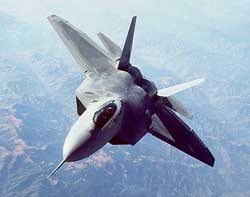
Hot refuelling is not a new concept, Recker said. "Many fighter units employ hot refuelling operations in conjunction with rearming and reloading ordnance, also known as an integrated combat turn. Together, integrated combat turns and hot refuelling get the aircraft back in the air in minimum time."
The Raptor was initially scheduled for integrated combat turn certification after April 2003, during the dedicated initial operational test and evaluation phase of testing. However, hot-pit refuelling tests have been brought forward in the test schedule as an initiative to add flexibility in test execution when tanker support may not be available, Recker said.
"When tankers are down for maintenance or sometimes not available because of real-world operational requirements, hot-pit refuelling allows for multiple sorties per test mission," Recker said. "Although test missions with airborne tanker support are more efficient, hot-pit refuelling between several sorties will go a long way towards providing the needed flight hours per test mission."
Aircraft that operate in hot-pit refuelling areas also undergo a brief, but thorough safety check upon landing to ensure the aircraft is ready to be refuelled and can return to the air.
Geneva Convention Applies to Taliban, not Al Qaeda
President Bush said the United States would regard the Geneva Conventions as applying to Taliban detainees under U.S. control -- but not Al Qaeda detainees.
Defense Secretary Donald Rumsfeld said today the United States would continue to treat all detainees humanely and in accordance with standards set by the Geneva Conventions.
Bush's decision does not materially change the way all detainees will be treated by the United States nor does it confer prisoner of war status on Taliban members. U.S. officials will continue to call both Taliban and Al Qaeda members "detainees." AFRTS TV Report: SecDef reacts to designation of Al Qaeda and Taliban detainees
Afghanistan signed the Geneva Convention of 1949. U.S. government lawyers determined the convention applies to Taliban captured since the war on terrorism began.
"The reality is the set of facts that exist today with the Al Qaeda and the Taliban were not necessarily the set of facts that were considered when the Geneva Convention was fashioned," Rumsfeld said in the Pentagon in an informal talk during the signing of a U.S.-Canada agreement on the Joint Strike Fighter.
Rumsfeld said the president decided the Al Qaeda would not fit under the Geneva Convention, because the Geneva Convention is an instrument among states in conflict. "The Al Qaeda is not a state; it is a terrorist organization," he said.
Bush decided that the Taliban would fit in the framework of the convention even though neither the United Nations nor virtually any country in the world recognized the Taliban as Afghanistan's legitimate government.
Rumsfeld said U.S. lawyers took their time in making their assessment because, "while it makes no difference in how these individuals will be treated, it could be considered a precedent for the future."
The decision means there is no need for tribunals under the Geneva Convention to judge the status of the Taliban or Al Qaeda detainees. The convention is written in a way that, in areas where there is doubt about the status of detainees, a tribunal sets their status. The tribunal is really a screening process, Rumsfeld said. However, a screening process has been in place since the detainees were captured. The process includes the defense establishment, the Department of Justice and the Central Intelligence Agency, he said.
The Geneva Convention tribunal process should not be confused with the proposed military commissions the United States may use to try some detainees for crimes.
[ Send Us News | Archives ]
by Gail Helmer
Friday February 08, 2002
- EU II Patch Released
- Takeda Patch Released
- Hidden and Dangerous Deluxe Announced
- All Crewmen Rescued After Helicopter Goes Down in Atlantic
- Canada Signs Commitment To JSF Fighter Programme
- Lockheed Martin's LOCAAS Successful In Flight Test
- Polish Government Seeks Amendment To Fighter Contract
- Raptor Gets Green Light On Refuelling Capability
- Geneva Convention Applies to Taliban, not Al Qaeda
EU II Patch Released
Strategy First has released new patches for Europa Universalis II, bringing the historical strategy game by Paradox to version 1.03. You can update from the previous v1.02 or the original game and this release "addresses some stability issues, AI fixes and game play tweaks." Download
Takeda Patch Released
Magitech has issued a new patch for Takeda, and this version 2.0 release adds "numerous new features and improvements" to their war game set in feudal Japan Download
Hidden and Dangerous Deluxe Announced
Lonely Cat Games has announced it is finishing work on Hidden and Dangerous Deluxe. A remake of Talonsoft and Illusion Softwork's 3D tactical shooter, Hidden and Dangerous and its Fight for Freedom expansion, the game is being adapted to run on Windows 2000 and Windows XP using DirectX 8.1. Hidden and Dangerous Deluxe utilizes an improved Insanity3D engine that takes advantage of the hardware vertex processing of modern 3D cards. Lonely Cats hopes to attract players to the game with updated compatibility, bug fixes, and faster game code together with added support for voice chat, GameSpy's matchmaking service, and dynamic shadows.
Military News
All Crewmen Rescued After Helicopter Goes Down in Atlantic
Four crewmembers were rescued after their helicopter went down in the Atlantic Ocean Thursday morning (Feb. 7), approximately 100 miles east of the Virginia Capes. The helicopter, attached to USS Seattle (AOE 3), was conducting a vertical replenishment (VERTREP) with USNS Mount Baker (T-AE 34) when the incident occurred at 10:24 a.m. (EST).

The four crewmembers of the Navy CH-46 "Sea Knight" have been identified as: Lt. Lance Collier, 31; Lt. j.g. Cyndee Brittingham, 28; Aviation Machinist's Mate 2nd Class Kevin Maul, 29; and Aviation Electronics Technician 3rd Class Clifton Lyons, 20. Hometowns were not immediately available.
All four crewmembers were recovered by a second helicopter, also participating in the VERTREP, were returned to USS Seattle. Maul and Lyons were unharmed; the two pilots received minor injuries. Both helicopters belong to Helicopter Combat Support Squadron 6, Detachment 4, embarked aboard Seattle. There was some minor damage done to the flight deck safety nets on Mount Baker. This incident is under investigation. USS Seattle is part of the USS John F. Kennedy (CV 67) Battle Group.
Canada Signs Commitment To JSF Fighter Programme
Canada has become the first country outside the US and UK, to put pen to paper in support of the Joint Strike Fighter (JSF) project, an aircraft that is expected to have a significant impact on the development of aerial warfare over the next thirty years.
US Under Secretary of Defense for Acquisition, Technology, and Logistics Edward C. "Pete" Aldridge, Jr., and his Canadian counterpart Assistant Deputy Minister for Materiel Alan Williams have signed a memorandum of understanding committing Canada to participate in the development and demonstration phase of the programme.

The agreement spans 10 years and will give Canada an advantage over other interested parties when it comes to acquisition of the aircraft. Canadian officials agreed to provide $150 US ($240 Can) million for the development of the prototype aircraft, by comparison the UK is providing $2 billion. "This agreement serves just about every facet of our two countries' national security imperatives," said Aldridge. "Not just in terms of air dominance, but also interoperability, defence transformation, modernisation, cost reduction, acquisition excellence, and the health of our industrial bases."
"This is an important agreement for both the Department of National Defence and Canadian industry," said Williams. "This project will enhance interoperability with US and allied forces, and will provide opportunities for Canadian industry to participate in this cutting-edge aerospace project."
Williams emphasised that the agreement would be of huge worth to Canadian industry: "when we talk in the short and medium term we're certainly talking in this phase, potentially up to 3500 to 5000 jobs we think. As you extrapolate that well into the future, the potential is enormous for maybe 60-plus thousand jobs. That again depends on how successful we are. But we're fairly comfortable that the economic impact in terms of jobs for Canada and Canadians is dramatic."
From the US point of view, the agreement lends credence to claims that the JSF aircraft, nominally the F-35, is generating significant interest from other countries such as the Netherlands, Italy, Denmark, Norway and Turkey. Needless to say prime contractors Lockheed Martin were delighted by the news.
"By joining the Systems Development and Demonstration phase, Canada strengthens the global nature of the programme and further validates the concept of the F-35 as a highly interoperable, common defence asset for multiple allies," said Dain M. Hancock, president of Lockheed Martin Aeronautics Company.
While the Canadian financial input is negligible in a project of this scale, the benefit for Canadian industry both in terms of jobs and experience in being involved in such a high-tech and high profile programme should be pronounced. Equally by attracting support from another western nation the US will be hoping that a bandwagon effect may take hold and that Mr Williams' signature is the first of many.
Lockheed Martin's LOCAAS Successful In Flight Test
Lockheed Martin Missiles and Fire Control's Low Cost Autonomous Attack System (LOCAAS) demonstrated full air vehicle flying qualities and guidance performance in a test this week at Eglin Air Force Base in Florida.
The powered submunition was launched from a test aircraft flying at 200 knots at an altitude of 1,500 feet. After weapon release, the missile flew through a series of pre-determined waypoints, proving its ability to follow a mission-planned course.

After it passed through the final waypoint, the weapon performed a series of sharp banks, rolls, and turns designed to demonstrate its aerodynamic capabilities.
"LOCAAS provides a unique capability to loiter over the battlefield and take out targets," said Colonel Thomas Masiello, Chief of Air Force Research Labs - Munitions at Eglin Air Force Base. "The warfighter will load in a flight plan and LOCAAS will take out any planned targets that appear in that predetermined area. Monday's test was typical of a mission planned course that LOCAAS might fly in a combat scenario."
LOCAAS uses a Laser Detection and Ranging (LADAR) seeker to determine target aimpoints automatically, using demonstrated Automatic Target Recognition algorithms. It is designed to be compatible with F-16, F-22, Joint Strike Fighter, B-1, and B-2 aircraft. It can also be dispensed from a Multiple Launch Rocket System (MLRS) rocket or an Army Tactical Missile System (ATACMS) missile.
Polish Government Seeks Amendment To Fighter Contract
The Polish Government is to submit proposals to Parliament to amend a $3 billion fighter acquisition programme designed to bring the country's ageing air force up to NATO standards. The original programme requirements were for 44 new aircraft along with 16 second hand aircraft, but the defence ministry has now rethought the proposal raising the number of new aircraft to 48, enough for three squadrons, and scrapping the need for the old aircraft.
Poland, which has been a member of NATO since 1999, currently operates a fleet of sub-standard ex-Soviet fighters and so this project will mark an important stepping stone for Polish defensive capabilities. Pending parliamentary approval, the final decision should be taken in the autumn.



Competing for the tender are Lockheed Martin's F-16, Dassault's Mirage 2000 and the JAS-39 Gripen from a consortium of Saab and BAE SYSTEMS, and the three teams have recently presented their respective offset packages. This aspect of the competition is likely to be crucial as, in similar circumstances, both Hungary and the Czech Republic selected the Gripen due to the generous subcontracting work on offer for the aerospace sectors in those countries.
Raptor Gets Green Light On Refuelling Capability
The F-22 Combined Test Force at Edwards AFB in California has expanded the Raptor's operational capability by certifying the aircraft for "hot-pit" refuelling operations recently. After nearly five months of research, training and demonstrations, certification will allow the F-22 to be refuelled on the ground while the engines are operating.
The new certification is a first for the F-22 programme and expands the current operational capability of the platform, said 1st Lt. Roy Recker, chief of F-22 logistics test and evaluation.
Most often, hot-pit refuelling is done on a parking pad, adjacent to the aircraft runways, Recker said. After hot refuelling, the F-22 can return to the skies, to continue expanding the flight and avionics envelope.

Hot refuelling is not a new concept, Recker said. "Many fighter units employ hot refuelling operations in conjunction with rearming and reloading ordnance, also known as an integrated combat turn. Together, integrated combat turns and hot refuelling get the aircraft back in the air in minimum time."
The Raptor was initially scheduled for integrated combat turn certification after April 2003, during the dedicated initial operational test and evaluation phase of testing. However, hot-pit refuelling tests have been brought forward in the test schedule as an initiative to add flexibility in test execution when tanker support may not be available, Recker said.
"When tankers are down for maintenance or sometimes not available because of real-world operational requirements, hot-pit refuelling allows for multiple sorties per test mission," Recker said. "Although test missions with airborne tanker support are more efficient, hot-pit refuelling between several sorties will go a long way towards providing the needed flight hours per test mission."
Aircraft that operate in hot-pit refuelling areas also undergo a brief, but thorough safety check upon landing to ensure the aircraft is ready to be refuelled and can return to the air.
Geneva Convention Applies to Taliban, not Al Qaeda
President Bush said the United States would regard the Geneva Conventions as applying to Taliban detainees under U.S. control -- but not Al Qaeda detainees.
Defense Secretary Donald Rumsfeld said today the United States would continue to treat all detainees humanely and in accordance with standards set by the Geneva Conventions.
Bush's decision does not materially change the way all detainees will be treated by the United States nor does it confer prisoner of war status on Taliban members. U.S. officials will continue to call both Taliban and Al Qaeda members "detainees." AFRTS TV Report: SecDef reacts to designation of Al Qaeda and Taliban detainees
Afghanistan signed the Geneva Convention of 1949. U.S. government lawyers determined the convention applies to Taliban captured since the war on terrorism began.
"The reality is the set of facts that exist today with the Al Qaeda and the Taliban were not necessarily the set of facts that were considered when the Geneva Convention was fashioned," Rumsfeld said in the Pentagon in an informal talk during the signing of a U.S.-Canada agreement on the Joint Strike Fighter.
Rumsfeld said the president decided the Al Qaeda would not fit under the Geneva Convention, because the Geneva Convention is an instrument among states in conflict. "The Al Qaeda is not a state; it is a terrorist organization," he said.
Bush decided that the Taliban would fit in the framework of the convention even though neither the United Nations nor virtually any country in the world recognized the Taliban as Afghanistan's legitimate government.
Rumsfeld said U.S. lawyers took their time in making their assessment because, "while it makes no difference in how these individuals will be treated, it could be considered a precedent for the future."
The decision means there is no need for tribunals under the Geneva Convention to judge the status of the Taliban or Al Qaeda detainees. The convention is written in a way that, in areas where there is doubt about the status of detainees, a tribunal sets their status. The tribunal is really a screening process, Rumsfeld said. However, a screening process has been in place since the detainees were captured. The process includes the defense establishment, the Department of Justice and the Central Intelligence Agency, he said.
The Geneva Convention tribunal process should not be confused with the proposed military commissions the United States may use to try some detainees for crimes.
